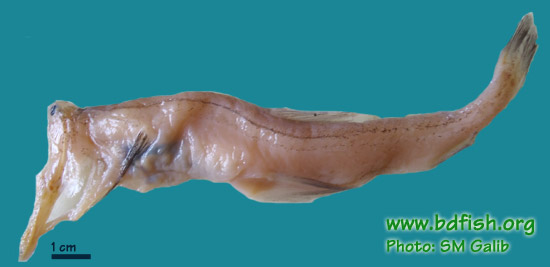
Systematic position
Phylum: Chordata
Class: Actinopterygii (Ray-finned fishes)
Order: Aulopiformes (Lizardfishes)
Family: Synodontidae (Lizardfishes)
Subfamily: Harpadontinae (Bombay ducks)
Genus: Harpadon
Species: H. nehereus
Common/local names
English: Bombay-duck and Bankagduel
Bangladesh: Bombay-duck (বোম্বাই ডাক), Loitta (লইট্টা) and Nihari (নিহারী)
India: Bumaloh, Lutia and Nehere (Talwar and Jhingran, 1991)
Synonym: Osmerus nehereus Hamilton, 1822
Distributions: Indo-west Pacific (Talwar and Jhingran, 1991).
Conservation status: Not threatened in Bangladesh (IUCN Bangladesh, 2000).
Morphology: Elongated and laterally compressed body. Eyes very small and covered by edipose membrane. Mouth very wide. Maxillaries absent. Lower jaw prominent and gill wide open. Scales deciduous, about 40 in lateral series and lateral line slightly keeled with about 40 fine rectangular membranous pieces covered with similar scales (Rahman, 1989 and 2005). Three pointed lobes in caudal fin.
Body color brownish to grayish with many black dots on back.
Fin formula:
D.12-13; P1. 11-12; P2. 9; A. 2(12-13) (Rahman, 1989 and 2005)
D 12-14; A 13-15; P i 10-11; V i 8 (Talwar and Jhingran, 1991)
Maximum lengths: 24.5 cm but attains up to 40 cm (Rahman, 1989 and 2005) and 40 cm (Talwar and Jhingran, 1991).
Habitats: Bay of Bengal and estuaries of Bangladesh, also ascends tidal rivers (Rahman, 1989 and 2005). Inhibits coastal waters and estuaries (Talwar and Jhingran, 1991). In Sundarban, it occurs in areas with salinity (Gopal and Chauhan, 2006). Recorded from semi-saline and saline water of the Sundarban (Bangladesh) (Hoq et al., 2006).
Abundant marine species in northwest coast of India (Rupsankar, 2010). During 1998-2001, this fish was the most abundant (42.82%) species in Changjiang (Yangtze) River estuary of China (Haicheng and Weiwei, 2009).

Fishery information and importance: This fish is of commercial significance (Rahman, 1989 and 2005). Used as food fish in Bangladesh and both fresh and sun-dried fish are used in this purpose. Rupsankar (2010) reported that traditionally the demand of fresh fish is limited and major portion of landings are converted to rope dried product. According to Rahman (1989 and 2005) it is highly esteemed as food particularly in Chittagong (Bangladesh) where these are found in abundance. He also mentioned that dried Bombay-duck is have commercial importance in south and southeast Asia. In India, this fish contributes a substantial fishery in the Hooghly estuary (West Bengal) (Talwar and Jhingran, 1991).
Kamal et al. (2001) treated this species as a under-utilized fish in Bangladesh and studied their gel forming ability. High moisture content (89%) and high enzymatic and bacteriological activity in this fish was reported by Rupsankar (2010). It is a low fat fish (Shankar et al., 2010).
Disease: Digenean parasites (Bucephalus harpodontis) of Bombay-duck was reported from Chinese waters by Liu et al. (2010).
_______________________________________________________
REFERENCES
Gopal B and Chauhan M. 2006. Biodiversity and its Conservation in the Sundarban Mangrove Ecosystem. Aquatic Sciences 68:338–354.
Haicheng Y and Weiwei X. 2009. The environment effect on fish assemblage structure in waters adjacent to the Changjiang (Yangtze) River estuary (1998–2001). Chinese Journal of Oceanology and Limnology 27(3):443-456.
Hamilton F. 1822 An account of the fishes found in the river Ganges and its branches. Edinburgh & London. An account of the fishes found in the river Ganges and its branches.: i-vii + 1-405, Pls. 1-39.
Hoq ME, Wahab MA and Islam MN. 2006. Hydrographic status of Sundarbans mangrove, Bangladesh with special reference to post-larvae and juveniles fish and shrimp abundance. Wetlands Ecology and Management 14:79–93.
IUCN Bangladesh. 2000. Red book of threatened fishes of Bangladesh, IUCN- The world conservation union. xii+116 pp.
Kamal M, Biswas BC, Yasmin L, Azimuddin KM and Islam MN. 2001. Influence of Temperature on the Gel-forming ability of Some Under-utilized Marine Fish Species in Bangladesh, Pakistan Journal of Biological Science 4(12):1525-1542.
Liu S, Peng W, Gao P, Fu M, Wu H, Lu M, Gao J and Xiao J. 2010. Digenean parasites of Chinese marine fishes: a list of species, hosts and geographical distribution. Syst. Parasitol. 75:1–52.
Rahman AKA. 1989. Freshwater Fishes of Bangladesh, 1st edition, Zoological Society of Bangladesh, Department of Zoology, University of Dhaka, Dhaka-1000, pp. 71-72.
Rahman AKA. 2005. Freshwater Fishes of Bangladesh, 2nd edition, Zoological Society of Bangladesh, Department of Zoology, University of Dhaka, Dhaka-1000, pp. 86-87.
Rupsankar C. 2010. Improvement of cooking quality and gel formation capacity of Bombay duck (Harpodon nehereus) fish meat. J. Food Sci. Technol. 47(5): 534-540.
Shankar TJ, Sokhansanj S, Bandyopadhyay S and Bawa AS. 2010. Storage Properties of Low Fat Fish and Rice Flour Coextrudates. Food Bioprocess Technol. 3:481–490.
Talwar PK and Jhingran AG. 1991. Inland Fishes of India and Adjacent Countries, Vol. 2, Oxford & IBH Publishing Co. Pvt. Ltd. New Delhi-Calcutta, pp. 724-725.
Visited 8,729 times, 1 visits today | Have any fisheries relevant question?
